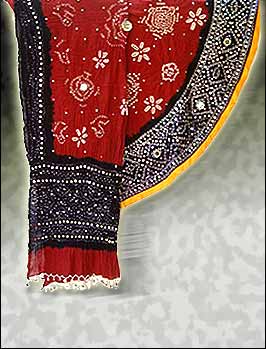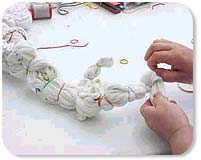





|
Best
viewed in Internet Explorer 5+ at a screen resolution of 1024 by 768
Pixels
Web-Site designed & maintained by WEB
SOLUTIONS
|
...Tie & Dye...
 Bandhej
or Bandhni is the Art of royalty
Bandhej
or Bandhni is the Art of royalty
Tie and dye is one of the most widely accepted and one of the very traditional methods of printing textiles in India. According to the design and the motif, each pattern has its special significance. The chandokhni and shikhara are specially created for the brides. The barah baag, when opened looks like a garden of flowers - a set of 12 (barah) beds of flowers. There was also a design called bavan (52) baag, but no one makes it now because it takes too much time and labor.
Ambadal, a network of branches and leaves interwoven with a variety of birds, represents the branches of a mango tree. Chokidal is a pattern of squares with elephants and other animals. And then there is kambaliya - a design with a dotted pattern in the center and a different design along the border. The basant bahar represents the flowers of spring, the mor zad - a peacock pattern, etc. All these designs are traditional. Any new design that a craftsman of modern times creates is called fancy.
Origin
Of Tie And Dye
It is difficult to trace the origins of this craft to any particular area.
According to some references it first developed in Jaipur in the form of leheriya.
But it is widely believed that it was brought to Kutch from Sindh by Muslim
Khatris who are still the largest community involved in the craft. Bandhni
was introduced in Jamnagar when the city was founded 400 years ago. This city
has now become one of the principal centers of bandhni, creating new pattern
and experimenting with modern colors. The earliest reference to bandhni is
in Bana Bhatt's Harshacharita, where he describes a royal wedding, "the
old matrons were skilled in many sorts of textile patterning, some of which
were in the process of being tied (bandhya mana)". This material was
used to make the skirts for women. A bandhni garment was considered auspicious
for the bride. One also finds the maids in the Ajanta wall paintings wearing
blouses of tie and dye patterns.
Tie
And Dye Today
Today women and girls can be seen sitting in their homes with pieces of malmal
(fine muslin), handloom or silk cloth. This cloth is first bleached and then
folded into two or four layers depending on the thickness of the cloth. A
rangara or designer marks the layout of the pattern on the material using
wooden blocks dipped in geru, a burnt sienna color mixed with water. The craftsmen
then begin to tie the cloth, which is not to be dyed. The folds of the material
within the small motif are lifted and tied together. The material with the
first set of ties is dyed yellow. There is also a process, mostly followed
in Rajasthan of dyeing parts of the material by hand - lipai technique. The
material is again tied and dyed into red or green. If the border has to be
darker all the lighter parts are tied and covered with plastics foil and the
edges are dyed with the required colors. Repeated tying and dyeing produces
elaborate designs.
Raw
Materials Needed
The raw materials required for bandhni are - muslin, handloom or silk cloth,
ordinary thread for tying, starch and colors for dyeing. Traditionally vegetable
dyes were used but today chemical dyes are becoming very popular. The tools
required are also very basic - wooden blocks for marking designs and the simple
implements for dyeing.
Colors
Used
The colors commonly used in bandhni are - red, a symbol of marriage, saffron,
a color worn by yogi who has renounced the world, yellow, which stands for
spring and black and maroon, used for mourning. Bandhni material is sold folded
and with the knots tied. One has to pull the folds apart for the knots to
open. The payment is made according to the number of dots in the pattern.
An intricate design in a sari would have approximately 75000 dots. What is
essential in bandhni is the minute and skilful manipulation of the fingers
for tying, extensive knowledge of color schemes and skill in dyeing materials.
It takes several years for a craftsman to perfect his skill. Bandhni saris
and dupattas are available at most shops all over India but to get the authentic
material, it is advisable to buy it from Rajasthan or Gujarat emporia which
have outlets in all major cities or from CraftsInIndia.
Preparation
And Process Involved in Tie And Dye Weaving
The process of tie and dye weaving starts with preparing the warp and weft
from the bleached silk yarn by spinning it. Squatted on the floor, women reel
threads from primitive spinning wheels to load bobbins. Giant spinning wheels
areemployed to prepare the warp, which forms the length of the fabric. The
warp is fastened between two poles set apart and marked according to the  design.
For preparing the weft (which forms the width), a fan-shaped, spiked wooden
frame is used. Strand upon strand of yarn is deftly wound between the spikes
and the converging rod at the other end of the frame. The yarn is tied with
threads and strips of rubber, in line with the predetermined pattern marked
on it. The warp and weft yarns are individually knotted and wrapped tight
enough to prevent the dye from penetrating into it when dipped in different
colors. This is called double-tie-dye method. The process of tying and dyeing
is repeated several times depending on the number of colors required by the
design. When the yarn has dried, the wrappings are carefully removed. The
yarn, which is to become the length of the fabric to be woven, is stretched
on the loom while the weft yarn is once again transferred to the fan-shaped
wooden frame. At this stage one can see the patterns emerging, ready to be
woven together. The craft of tie-dyed weaving is known as Chitki in Telugu.
But its popular name, however, is Ikat. The technique involves great skill
and precise calculations by the textile artisans. The design is very colorful,
intricate and attractive but at the same time very complicated. It takes nearly
15-20 days to weave a cloth of 20 meters - the maximum length a loom can take.
The woven fabric is taken out of the loom and given a starch-polish before
sending it to the showroom.
design.
For preparing the weft (which forms the width), a fan-shaped, spiked wooden
frame is used. Strand upon strand of yarn is deftly wound between the spikes
and the converging rod at the other end of the frame. The yarn is tied with
threads and strips of rubber, in line with the predetermined pattern marked
on it. The warp and weft yarns are individually knotted and wrapped tight
enough to prevent the dye from penetrating into it when dipped in different
colors. This is called double-tie-dye method. The process of tying and dyeing
is repeated several times depending on the number of colors required by the
design. When the yarn has dried, the wrappings are carefully removed. The
yarn, which is to become the length of the fabric to be woven, is stretched
on the loom while the weft yarn is once again transferred to the fan-shaped
wooden frame. At this stage one can see the patterns emerging, ready to be
woven together. The craft of tie-dyed weaving is known as Chitki in Telugu.
But its popular name, however, is Ikat. The technique involves great skill
and precise calculations by the textile artisans. The design is very colorful,
intricate and attractive but at the same time very complicated. It takes nearly
15-20 days to weave a cloth of 20 meters - the maximum length a loom can take.
The woven fabric is taken out of the loom and given a starch-polish before
sending it to the showroom.